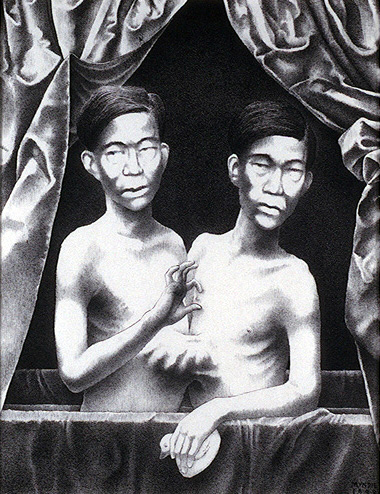The subjects of this portrait are Chang & Eng Bunker, the eponymous
"Siamese Twins." Chang & Eng were born in 1811 to Chinese parents
in the country now known as Thailand. As babies, the twins escaped a death
sentence imposed upon them by King Rama II, who believed they were an ill
omen. The twins later gained sufficient royal favor to act as ambassador to Cochin China for
Rama II's successor. Chang & Eng were brought to Boston by an enterprising American sea
captain in 1829, and proceeded to exhibit themselves in the United States and Europe
for many years before retiring as wealthy slave-owning planters in ante-bellum
North Carolina. The twins became naturalized American citizens, adopted
the surname Bunker, married a pair of sisters, and proceeded to father
twenty-one children between them. Financially ruined in the wake of the
Civil War, the twins returned to show business to regain what they had lost.
Conjoined twins inspire a particular fascination, which I believe is due in part to one's
notions of privacy. It is the salacious details that interest people most. "How do they use the
rest room?" and like questions are foremost, because for conjoined twins every mundane
bodily function or private romantic encounter is a group effort.
The inspiration for this portrait was two-fold: that curious and famous painting
attributed to the School of Fontainebleau, sometimes called Portrait
of the Beautiful Gabrielle and the Maréchale de Balagny;
and the plaster death cast of Chang & Eng house at the Mütter Museum
of the College of Physicians of Philadelphia. So, here we have Chang &
Eng sharing a "private" moment in the tub where — just as with those enigmatic
French sisters — Eng is playfully tweaking his brother's nipple; yet despite
the high spirits, both wear the mournful expression they invariably presented
for the camera.
[To see more drawings from this series, please visit the Prodigies
website at
missionCREEP.com]



